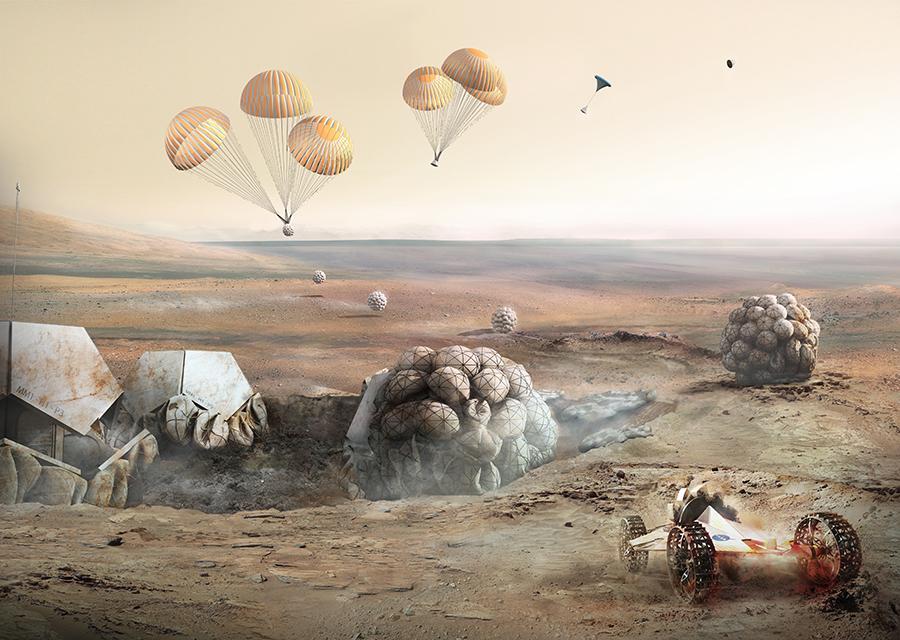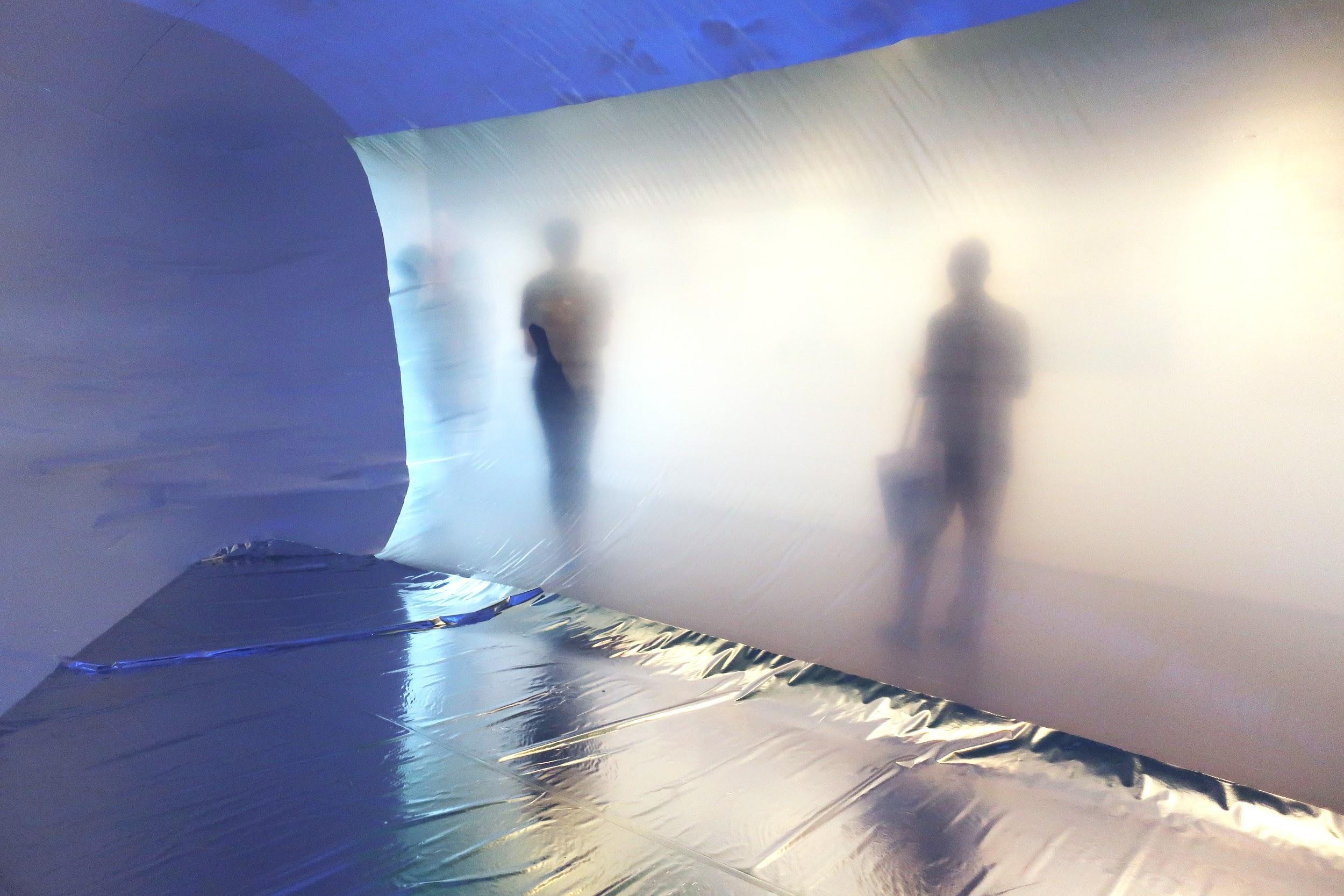This week’s contributing blogger, Avery Robertson, is a fifth year undergrad student at Northeastern University in Boston Massachusetts studying Architectural Studies with a concentration in Sustainable Design. She recently worked at the Boston Society of Architects as the coordinator for the 2017 Common Boston Festival of Architecture and Design.
The concept of utopia is one that is constantly fluctuating. Its deep ties to architecture are influenced by cultural shifts that revive and revamp past ideas for current use in applications from science fiction to environmental design. One such idea that is currently experiencing a new life is inflatables, which are rising in popularity as both an aesthetic and practical material choice. This can be seen with recent works like the ethereal 2013 Ark Nova by Arata Isozaki and Anish Kapoor and the futuristic 2015 Mars Habitation from Foster + Partners.

Habitat on Mars by Foster + Partners. Image courtesy Foster + Partners.
The concept uses inflatables as a practical material in creating futuristic habitation for humans on Mars.
Curated by Mary E. Hale, AIA, and Katarzyna Balug, the BSA Space presents The New Inflatable Moment. Getting its name from a play on the title of a 1998 exhibition and book “The Inflatable Moment: Pneumatics and Protest in ‘68” by Marc Dessauce and The Architectural League of New York, the exhibition is comprised of projects that feature the application of inflatables in relation to architecture, art, culture, technology, and science. Monopolizing on the new inflatable architectural resurgence, the exhibition explores how key works in the movement were influenced by the correlating time-sensitive idea of utopia. Through photographs, drawings, videos, models, and interactive installations, the visitor is provided with an extensive history of inflatables in the context of their relationship to architecture, art, and science fiction.
Upon entering the exhibition, there is an interactive data visualization display titled Chronorhythms by design science office Certain Measures. The display hosts a timeline of when the key terms “utopia”, “inflatable”, “pneumatic”, and “revolution” were most popular in relation to important or pivotal events. Displayed on a 12-foot screen, the visitor is encouraged to tune a dial to activate the display and move through the fluctuating timeline, prompting one to question not just when by why these related terms became more or less popular. Interestingly, the prevalence of inflatables in design correlates to popularity of utopia and human relation to it. Between impossible hypothetical projects and practical actualized works, the adoptions of the medium are rooted in cultural and social movements and avant-garde responses.
Beginning with the archetypical pneumatic, the first work on display is a 1790 print of a Montgolfier hot air balloon. Showing projects both classic and eccentric, the subsequent works are divided into sections with titles such as “New Worlds” and “Phenomenal Optimism” that explore inflatable applications in science, mythology, mechanics, environmental design, engineering, and more. One section focuses on science fiction and futuristic habitats, showing first an image of a 1960 Buckminster Fuller inflated geodesic dome, then the 2015 Aerocene explorer kit from Tomàs Saraceno. The images are meant to relate but are allotted little space for display and description. When I further researched the Saraceno work, I saw that it was attempting to create cloud cities out of the Aerocene Explorer backpacks, cities that are reminiscent of the Fuller geodesic domes. By seeing only the compacted backpack the connection was unclear, yet interesting nonetheless. The description led me to look into both the works more.
The exhibition hosts a great collection that highlights pieces from key periods in the history of inflatables. Beginning the timeline in the 1700s through to the future amasses a quantity of works that are all quite notable and worth exploring more deeply. The visitor, however, may reach the point of information overload, resulting in easily passing over important works, data, and connections that are integral to understanding.

Inside The Moment. Photo courtesy Avery Robertson.
The curators have created a work of inflatable architecture for the visitor to experience within the exhibition.
The exhibition also includes a large scale inflatable that the visitor is encouraged to interact with. Designed by the curators, The Moment is a large bubble shape made of white and mylar synthetic fabric that the visitor enters through a zippered slice. In the softly lit enclosure, one “wall” of the membrane is thin and white, rendering outside passersby as foggy silhouettes. The absence of corners, hard lines, or solid structure gives the visitor the ability to experience firsthand what makes inflatable architecture unique, and different from typical concrete architecture.
Inflatable architecture allows for light and openness in design rather than solidity and density, and it generates a new dialogue in technology and materiality. The New Inflatable Moment makes the case that inflatables hold an important place in architecture and the progress of design. By showcasing works from 1970s art collectives to urban planning projects and space exploration, inflatables are given a strong affirmation of legitimacy and potential. Inflatable architecture and its relation to utopia is a design concept worth exploring in the coming age, and this exhibition provides interesting projects from numerous contexts along with interactive elements that bring the visitor into the world of these pneumatic structures.
